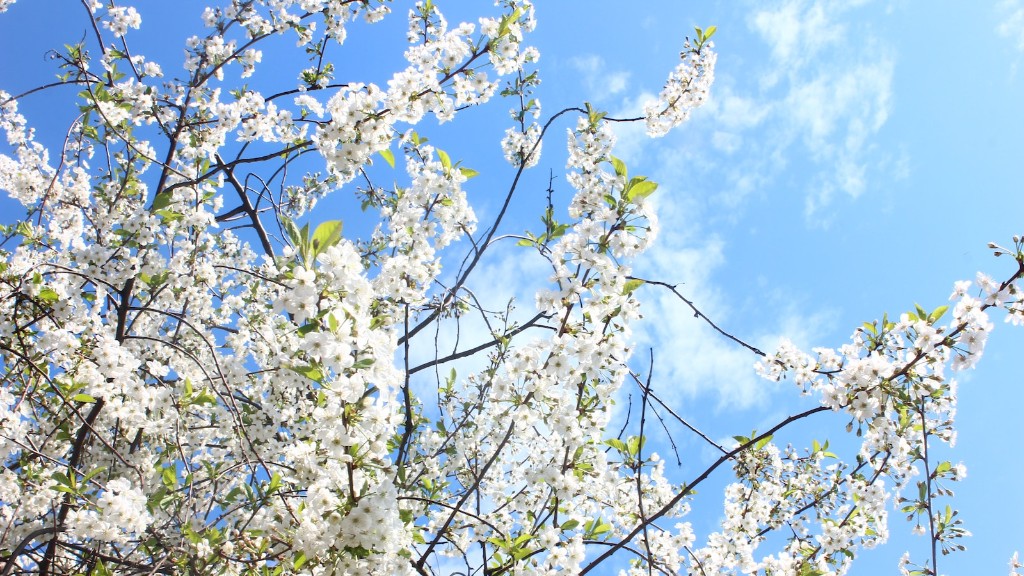Pruning an apple tree in fall is an important landscape maintenance practice that can improve the health and vigor of the tree. Before getting started, it is important to ensure that all pruning tools are sharp and clean to prevent introducing any diseases to the trees. To begin pruning, the first thing to do is to remove any dead or broken branches. These can be easily identified and removed with pruning shears or loppers. Next, it’s important to remove all branches that are crossing, rubbing against each other, or growing inward. This helps to promote air circulation and allows light to penetrate the tree, resulting in vigorous growth and improved fruit production.
Additionally, it is essential to remove any suckers growing from the ground or up from the trunk at the union of two branches. These should be taken off with a sharp pair of pruning shears. If the remaining branches are too large or overgrown, they should be pruned back to the branch collar. The branch collar is a slightly swollen area near the base of the branch that indicates the point of origin of the branch. When pruning back to the branch collar, it is important to avoid cutting through it, as this can create an entry point for disease. Make sure to open up the center of the tree, so light and air can circulate.
When pruning during the fall season, it is important to keep in mind the timing. Prune at least 4 weeks before the first hard frost to ensure that new growth is well established prior to the cold temperatures. Pruning too early can lead to new growth that is not well established by the time winter comes around. Wait until at least 6 to 8 weeks after petal fall to prune in order to avoid pruning off next year’s fruits. The best time to prune is in late fall or early winter, after all of the leaves have fallen off of the apple tree. If there are any leaves remaining, you may want to wait until those have fallen off too.
One of the most important things to remember when pruning any tree is to avoid topping or large heading cuts. Topping is when you cut back the top of a tree, which can cause malformation of the branches and make the tree more prone to certain diseases. Instead, use small heading cuts to shape and size the tree as desired. Pruning an apple tree may seem daunting, but with the proper techniques and a bit of practice, it can be an enjoyable and rewarding process.
Importance of Pruning
Pruning is a necessary practice for maintaining a healthy apple tree. Pruning removes dead or injured branches that can become entry points for disease and pests, while controlling the shape and size of the tree. Proper pruning techniques can improve the quality of the fruit and encourage the apple tree to produce more fruits. Pruning also promotes better air circulation, improving the overall health of the tree. Finally, pruning is important because it encourages the growth of new branches and foliage, which are essential for bearing fruit. Without proper pruning practices, the overall yield of apples from the tree will be significantly decreased.
In addition to the benefits of pruning to the overall health of the apple tree, pruning can also help reduce the risk of storm damage. Pruning helps reduce the amount of wind resistance from large branches, plus it can be used to help remove dead or weak branches. Removing these branches helps reduce the amount of damage that may occur during winter storms or heavy winds. Pruning helps open up the tree canopy and reduce the weight of the tree, helping to protect it from wind damage.
Finally, one of the greatest benefits of pruning is aesthetics. Proper pruning can help maintain a desired shape for the tree, allowing it to look neat and attractive. Pruning can also be used to remove any unwanted branches and open up the interior of the tree, allowing sunlight to enter and promoting healthy foliage. Pruning an apple tree in the fall can help it look great and ensure that the fruit it produces is of the highest quality.
Although pruning is beneficial, it must be done properly in order to get the most out of it. Pruning techniques, such as topping, should be avoided to ensure that the tree remains healthy and structurally balanced. It is also important to understand the correct timing of pruning to ensure optimal results. Pruning an apple tree in the fall is an important maintenance practice and must be done carefully and properly.
In conclusion, pruning apple trees during the fall season is essential for keeping them healthy and producing abundant, high-quality apples. Pruning helps to reduce the amount of wind resistance from the tree, prevents diseases and pests from entering, and encourages new growth. In addition, it is important to avoid making large heading cuts or topping the tree and to ensure pruning is done 4-6weeks before the first hard frost. Proper pruning techniques are important for maintaining the health of the tree and ensuring the highest quality of fruit in the coming year.
Tools for Pruning
When pruning an apple tree, it is important to use the proper tools to get the job done efficiently. Pruning shears and loppers are the most commonly used tools for pruning apple trees. Pruning shears are smaller and are best used for trimming small, dead twigs and branches. Loppers are larger and are used to cut small- to medium-sized branches. For the most accurate pruning, it is essential to use a sharp pair of pruning shears and loppers. Sharp tools make more accurate and cleaner cuts, resulting in more aesthetically pleasing and healthier trees.
The most important tool when pruning an apple tree is a good pair of glasses. Safety eyewear is a must when pruning as limbs and objects can fly off during trimming. It is also important to wear protective clothing such as long pants and closed-toe shoes. Protective gloves should also be worn to avoid any cuts or scratches while handling the tools.
When working around trees, it is also important to have a ladder that is the appropriate size and height. This allows for easy access to higher branches that may need pruning. Another important tool is a pruning saw. This special saw is used for larger branches that cannot be cut with pruning shears or loppers. When using any pruning saw, it is important to make sure the blade is sharp and to use extreme caution.
Pruning an apple tree requires the right tools for the job. Pruning shears, loppers, pruning saws, and safety glasses are essential for a successful pruning experience. It is also important to wear proper clothing and make sure the ladder is the right size and height. With the right tools and knowledge, pruning an apple tree can be a rewarding experience that results in a healthier tree and more successful fruit production.
Safety measures should always be taken when pruning any tree. It is important to be aware of the correct tools and the best techniques to use. The right tools and the right technique can make a huge difference in the health and vigor of an apple tree. With careful and detailed pruning, an apple tree can produce quality fruits in the next year. So, don’t forget to prune your apple tree in the fall for the best results.
Boosting Fruit Production
Pruning an apple tree in fall is a great way to increase fruit production for the upcoming season. Proper pruning helps to open up the tree allowing for better airflow and improved light penetration. This in turn encourages the growth of new branches and foliage, essential for bearing quality fruit the next year. Additionally, pruning can help reduce disease and pest infestations, as well as maintain the tree’s structural integrity.
Aside from pruning, there are several other techniques that can be used to help boost fruit production in an apple tree. One method is interplanting flowers and other beneficial plants near the base of the tree. This helps to increase the number of pollinators attracted to the garden, improving the chances of successful cross-pollination and giving the tree better fruit set.
Another technique that can help increase fruit production is inter-cropping plants around the apple tree. Planting certain crops near the tree can help attract beneficial insects that help to reduce the number of insects that cause damage to the fruit and foliage. Additionally, these plants can be used to provide additional support to the tree, allowing for improved structure and stability.
Finally, mulching is another method that can help improve the health and vigor of the apple tree and increase fruit production. Mulching helps to regulate the soil temperature, retain moisture, and reduce weeds and disease. Additionally, mulching helps to improve the fertility of the soil, which will result in improved fruit production in the tree.
In conclusion, proper pruning and other horticultural practices can help boost apple tree production for the upcoming season. Pruning helps to remove weak or diseased branches and open up the canopy, allowing more light and air to penetrate the tree. Additionally, intercropping plants, interplanting flowers, and mulching can all be beneficial to the health and fruit production of an apple tree. All of these practices will ensure a healthy and productive apple tree for many years to come.
Recycling Pruning Materials
Pruning an apple tree does generate a lot of material that can be recycled for use in other areas of the garden. Trimmings can be composted or used as mulch around the base of the tree. Composting helps to add organic matter to the soil and can help improve the soil health. Mulching can also help to reduce weeds, reduce the amount of water lost through evaporation, and regulate soil temperature.
Additionally, pruned apple tree branches can be used to create structure and support for other plants in the garden. Large branches can be used to create stakes for climbers such as vines and plants with heavy foliage, and smaller branches can be used to create trellises. Furthermore, prunings can also be used to make wreaths, which can be added to garden borders for decoration.
Finally, pruned apple tree branches can be used to make crafts and furniture. Wood from pruned apple tree branches can be used to make birdhouses, wooden planters, birdbaths, and small tables. Prunings can even be used to make garden gates or gazebos if there is enough available material. With a bit of creativity and hard work, discarded prunings can be transformed into something new and useful.
In conclusion, pruning an apple tree creates a good amount of material that can be used in other areas of the garden. Composting, mulching, and using the wood for other garden structures are all good ways to use trimmed branches. Additionally, creative gardeners can use pruned material to make crafts, furniture, and decorations, ultimately making better use of the pruning waste. By recycling pruned materials, gardeners can make their gardens more efficient and reduce the amount of waste sent to the landfill.




